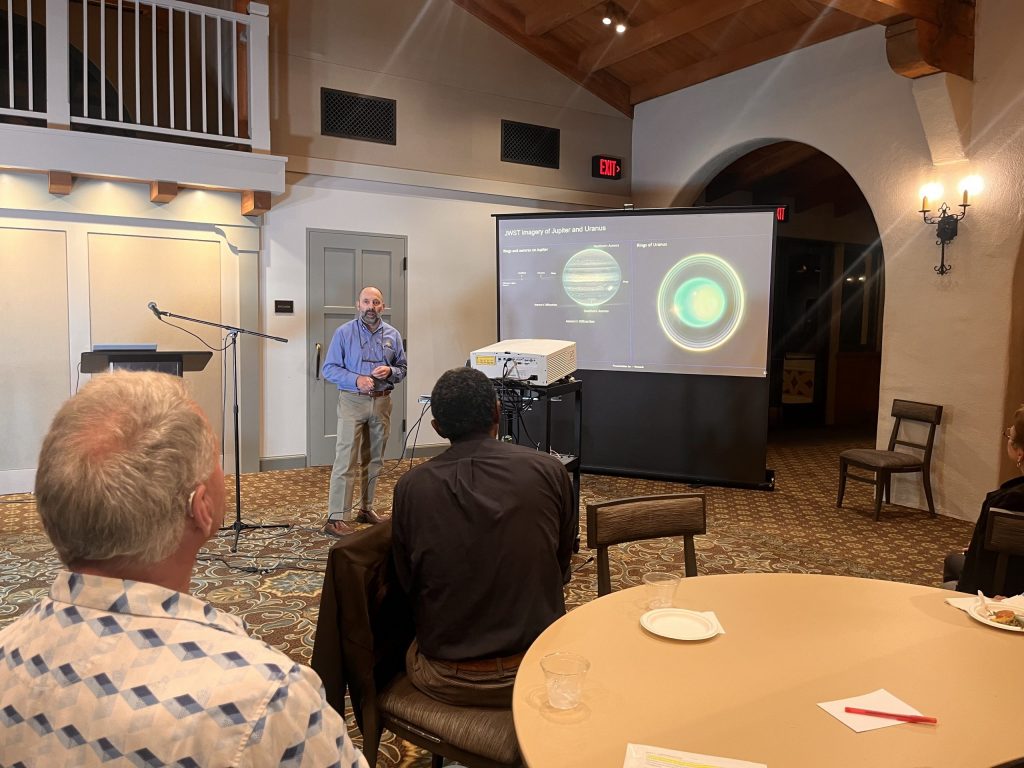James Webb Space Telescope relies on Central Coast’s infrared innovation

It took more than 15 years and the help of numerous companies for the James Webb Space Telescope to come to life.
But in doing so, it has also brought with it an entirely new way for the common person to life beyond this earth.
“How does the universe work? How did we get here? Where are we going? Are we alone? These are the central questions that drive our NASA astrophysics and the Webb mission enables the next step in humanity’s quest for the answers to those questions,” Dr. Matthew Greenhouse, an astrophysicist at NASA, said.
Greenhouse was the keynote speaker for Ventech’s event held on Nov. 8 giving an audience of nearly 200 at the Cabrillo Pavilion an opportunity to learn how the Webb Telescope came together and why it is important.
During his speech, Greenhouse noted an intricate multilayer sunshield the size of a tennis court that enables the Webb Telescope to operate at cryogenic temperatures, or extremely low temperatures, as low as -130 degrees fahrenheit.
“The JWST sunshield has an SPF of a million, so if you have it on the beach, it would be very well protected,” Greenhouse said.
Despite the joke, Greenhouse noted that the sunshield was actually one of the more difficult parts of the mission.
“Developing this sunshield and figuring out how to deploy it reliably was really one of the most challenging aspects of the Webb mission and one of the things that we’re most worried about,” he said.
The reason is because it took a lot for the sunshield to even deploy. Greenhouse said getting that thing deployed involves 140 release mechanisms, hinge assemblies, a lot of motors, all of which are single points of failure.
“Any one of those things didn’t work, the whole mission is over,” Greenhouse said.
“This was the highest risk part of the mission but it all worked perfectly and it is operating at its intended temperature.”
Greenhouse also described the beryllium hexangle mirrors that were assembled in space to complete the primary mirror.
The eyes of the telescope also have infrared camera sensors developed and built locally by Raytheon and Teledyne.
The story of how infrared sensor technology found its way to Santa Barbara was also highlighted.
An early entrepreneur named Dave Evans came to Santa Barbara in the early 1950s and founded the Santa Barbara Research Center, which became an active player in the research and development of infrared sensors.
That organization is now called Raytheon Vision Systems.
“We’re very fortunate that we have companies like Teledyne and Raytheon to make the eyes of JSWT and they just all happen to be here in this area,” Greenhouse said.
“But without that technology, which doesn’t exist anywhere else in the world, none of this would be possible.”
Previous Business Times reporting highlighted that Teledyne’s infrared technology also allows Webb to analyze data with spectroscopy, a scientific method of studying objects based on color. According to James Beletic, president of Teledyne Imaging Sensors, most of Webb’s observation time will be used for spectroscopy, since scientists use it to determine the composition, temperature, density and velocity of objects in space.
Teledyne’s infrared detectors helped scientists use spectroscopy to analyze the exoplanet in one of NASA’s released images, helping them discover water in the planet’s atmosphere, Beletic said.
Around 150 Teledyne employees worked on Webb-related projects for 20 years.
“We got selected for the James Webb Telescope because we make the best infrared detectors in the world,” Beletic said in a 2022 Business Times interview.
“I’m not just bragging about that. That’s what our customers come in and tell us. Because of that, if there’s an earth science mission or an astronomy mission, we’re usually selected for those.”
Though they were not mentioned at this event, other local companies such as Next Intent, a manufacturing company based in San Luis Obispo, built parts for Webb from 2000 to 2002.
In fact, it manufactured 150 test bed actuator assemblies for a one-sixth scale model of Webb. The actuators fit on the back of Webb’s 18 beryllium mirrors, shaping their curvature to capture images with an accuracy measured in nanometers.
Finally, Moorpark-based Ensign-Bickford Aerospace & Defense worked on Webb for more than 12 years, manufacturing 178 hold-down-release mechanisms, which stowed the telescope’s parts during launch.
email: [email protected]









